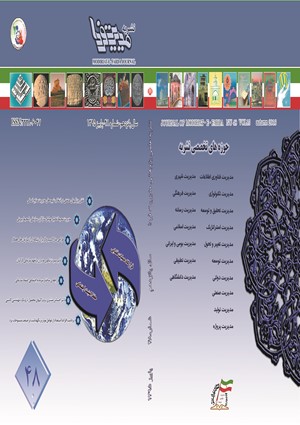معماری کلان نظام ارزیابی حوزه سلامت ایران
محورهای موضوعی :
1 - علم و صنعت
کلید واژه: معماری سازمانی نظارت و ارزیابی حوزه سلامت, ایران,
چکیده مقاله :
سلامت، يکي از اساسيترين نيازهاي همه انسانهاست و هيچ يک از افراد جامعه را نميتوان بينياز از آن دانست. سلامت فرد و جامعه در گرو ارائه خدماتي با کيفيت، مناسب و متناسب با نياز مردم است. اما بخش قابل توجهي از توان فعالان حوزه سلامت صرف تأمين و ارائه خدمات شده و بخش سياستگذاري، نظارت و ارزشيابي در آن کمرنگ جلوه مينمايد. اين ضعف منجر به اين امر گرديده است که ارائه خدمات سلامت دچار نقصان و ضعف جدي بوده و نتواند انتظارات عمومي را به نحو مطلوبي پاسخ دهد. با هدف قرار دادن این شکاف از یک طرف و بحث برجسته نظارت و ارزیابی در نظام سلامت از طرف دیگر، در این مقاله بنا داریم تا به معماری و بازطراحی کلان نظام ارزیابی در حوزه سلامت ایران بپردازیم. بدین منظور پس از طراحی مدل ارتباط مفاهیم حوزه ارزیابی و تعریف نقش های ممکن در این حوزه در نظام سلامت ایران، به توزیع مطلوب این نقش ها در بین فعالان این حوزه پرداخته ایم. بنا بر نتایج معماری صورت گرفته، توصیه می گردد تا سازوکار ايجاد و استقرار سازمانهايي با ماهيت عمومي غيردولتي و نحوه تعاملات آنها با يکديگر و با وزارت بهداشت، به منظور تدوین و جمع آوری شاخص های سلامت از یک طرف و انجام ارزيابي و اعتباربخشي به محصولات، خدمات و فعالان این عرصه از طرف دیگر، تدوین گردد.
Healthcare is one of the basic needs of all human beings and none of the people is needless from it. Personal and public health depends on providing appropriate, adequate and quality services. But a significant portion of the potency of the healthcare activists spent on providing health services and policy-making, monitoring and assessment is neglected. This weakness has led to the fact that the health care services is seriously flawed and unable to properly respond to public expectations. By considering the importance of assessment and supervision and aiming to fill this gap, this paper will architecture the healthcare assessment system in Iran. Therefore, after the design of conceptual model of assessment sector and definition of possible roles, we have distributed the roles between activists of this sector. Based on architecture results, it is suggested to set up organizations with public and non-governmental nature to collect and codify the healthcare indicators and also perform the assessment and accreditation of the healthcare production, services and activists.
1. دیباچه قانون اساسی جمهوری اسلامی ایران.#
2. قانون برنامه چهارم توسعه اقتصادی، اجتماعی و فرهنگی جمهوری اسلامی ایران (1384-1388)، سازمان مدیریت و برنامه¬ریزی.#
3. سند چشم¬انداز جمهوری اسلامی ایران و سیاست¬های کلی برنامه چهارم توسعه ابلاغی مقام معظم رهبری، سازمان مدیریت و برنامه¬ریزی، 1382#
4. سند ملی توسعه سلامت در برنامه چهارم توسعه اقتصادی، اجتماعی و فرهنگی کشور، معاونت هماهنگی و دبیر مجامع، وزارت بهداشت، درمان و آموزش پزشکی، 1384#
5. قانون وظایف وزارت بهداشت، درمان و آموزش پزشکی، مصوب 03/03/1367 مجلس شورای اسلامی.#
6. Mentz J, Kotzeand P, Van Der Merve A (2012). “A Comparison of Practitioner and Researcher Definitions of Enterprise Architecture using an Interpretation Method”. Advances in Enterprise Information Systems II, CRC Press, pp. 11-26.#
7. Jarvis R (2003). “Enterprise Architecture: Understanding the Bigger Picture - A Best Practice Guide for Decision Makers in IT”. UK National Computing Centre, Manchester, UK.#
8. Giachetti R.E (2010). “Design of Enterprise Systems, Theory, Architecture, and Methods”. CRC Press, Boca Raton, FL.
9. Franke U, Hook D, Konig J, Lagerstrom R, Narman P, Ullberg J, Gustafsson P, Ekstedt M. (2009). “EAF2-A Framework for Categorizing Enterprise Architecture Frameworks”. 10th ACIS International Conference on Software Engineering, Artificial Intelligences, Networking and Parallel/Distributed Computing, IEEE.#
10. Ross J.W, Weill P, Robertson D (2006). “Enterprise architecture as strategy: Creating a foundation for business execution”. Harvard Business School Press.#
11. Dankova C (2009). “Main Aspects of Enterprise Architecture Concept”. Economic Alternatives, p. 102-114.#
12. Chen D, Doumeingts G, Vernadat F (2008). “Architecture for enterprise integration and interoperability: past, present and future”. Computers in Industry, 59: p.647-659.#


